Carl E. Olson's Blog, page 339
March 22, 2011
Divine Revelation and Human Experience
Fr. Robert Barron of Word on Fire reflects on the reality of divine revelation, and the role of the Holy Spirit, the Church, and magisterial authority in defining and recognizing that revelation:
Related IgnatiusInsight.com Articles and Book Excerpts:
• The Divine Authority of Scripture vs. the "Hermeneutic of Suspicion" | James Hitchcock
• God, The Author of Scripture | Preface to God and His Image: An Outline of Biblical Theology | Fr. Dominique Barthélemy, O.P.
• Foreword to The Meaning of Tradition | Avery Cardinal Dulles
• Tradition | Thomas Howard
• Approaching the Sacred Scriptures | Scott Hahn and Curtis Mitch
• What Is Tradition? | Yves Congar, O.P. | The Introduction to The Meaning of Tradition
• Introduction to The Gift of Infallibility | Rev. James T. O'Connor
• Peter and Succession | Joseph Cardinal Ratzinger
• St. Peter and the Primacy of Rome | Stephen K. Ray
• Church Authority and the Petrine Element | Hans Urs von Balthasar
• The Papacy and Ecumenism | Rev. Adriano Garuti, O.F.M.
• What Is the Magisterium? | Thomas Storck
• Vatican II and the Ecclesiology of Joseph Ratzinger | Fr. Maximilian Heinrich Heim
• The Church Is the Goal of All Things | Christoph Cardinal Schönborn
• Motherhood of the Entire Church | Henri de Lubac
• Excerpts from Theology of the Church | Charles Cardinal Journet
• Authority and Dissent in the Catholic Church | Dr. William E. May
• Understanding The Hierarchy of Truths | Douglas Bushman, S.T.L.
Jimmy Akin answers the question: "What anti-pope is also a saint?"
Jimmy Akin, well-known apologist and author of the new book, The Fathers Know Best: Your Essential Guide to the Teachings of the Early Church, answers the question, "What anti-pope is also a saint?":
More about The Fathers Know Best :
The Fathers Know Best is a unique resource. It introduces you to the teachings of the first Christians in a way no other work can, and is specially designed to make it easy for you to find the information you want and need. 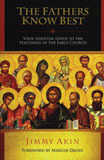
Features in book include:
• More than 900 quotations from the writings of the early Church Fathers, as well as from rare and important documents dating back to the dawn of Christian history.
• Mini-biographies of nearly 100 Fathers, as well as descriptions of dozens of key early councils and writings.
• A concise history of the dramatic spread of Christianity after Jesus told his disciples to evangelize all nations.
• Special maps showing you where the Fathers lived, including many little-known and long-vanished locations.
• A guide to nearly 30 ancient heresies, many of which have returned to haunt the modern world.
• The Fathers' teaching on nearly 50 topics, including modern hot-button issues like abortion, homosexuality, and divorce.
This groundbreaking work presents the teachings of the early Christians in a way unlike any other book. It flings open the doors of the crucial but little-known age covering the birth of Christianity and the triumphant march of the gospel throughout the ancient world.
Paperback, 450 pages.
March 21, 2011
Can Ignatius Press e-books be viewed on Android?
A reader asks, "Any chance Ignatius e-books might be available on Android soon?"
John Herreid, who works in the Ignatius Press marketing departments, answers:
Per our e-book download page, these should all work for Android:
ePub is now a standard e-book file format that is supported by almost* every e-book reading device including iPad, iPhone, iPod Touch, Kobo, Sony Reader, BeBook, IREX Reader, and the Nook from Barnes & Noble's. ePub is basically a .zip file that contains a collection of text files and images. Please note: in order to read epub files on your Nook or Sony Reader, you will need to change the .zip extension to .epub. Do not attempt to extract the file, simply change the extension.
Other than hardware devices, you can also read .epub books on your desktop or mobile phone using free e-reader software like Stanza, Mobipocket, FBReader (for Linux), Aldiko (for Android) or Adobe Digital Editions.
He points readers to the Ignatius.com page, "Instructions for Ignatius Press Download Files", which contains a wealth of information about e-books and related items.
• New E-books (of older print books) from Ignatius Press (March 16, 2011)
• All E-books available from Ignatius Press (www.ignatius.com)
Gazing into the waters of salvation, entering the doors of the Kingdom
Yesterday, our new adopted youngest son received the Sacraments of Baptism, Chrismation, and Holy Communion. Prior to the liturgy, his godfather, Tony Clark, took this picture of me gazing into the baptismal basin:
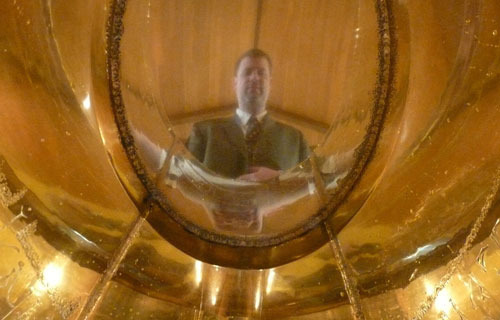
Of course, I'm taking a little bit of liberty with the title of this post, as the water had not yet been blessed by Father Janowicz. Here is the basin before the iconostasis:
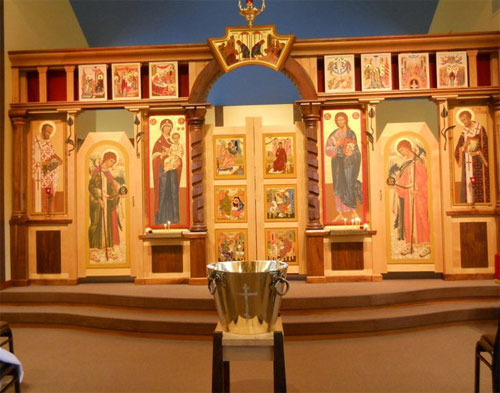
Receiving the Most Holy Eucharist for the first time:
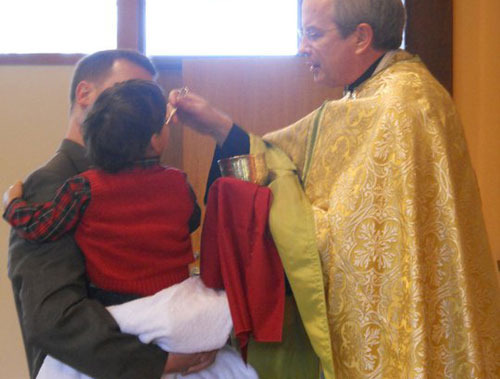
Following the reception of the three sacraments, the newly baptized is taken by the priest through the Royal Doors, into the sanctuary and before the altar, a powerful representation of entrance into full communion with God, the Giver of live and Lover of mankind:
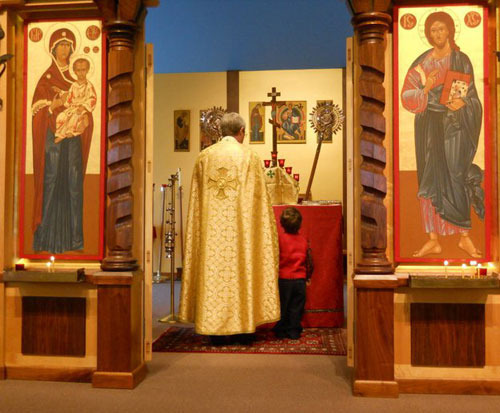
A special thanks to Tony and Amanda Clark and Leann Svarverud for the photos!
Finally, a beautiful quote from St. John Chrysostom about baptism and the new man:
In Baptism are completed the articles of our covenant with God; burial and death, resurrection and life; and these take place all at once. For when we plunge our heads down in the water, the old man is buried in a tomb below, and wholly sunk for ever; then, as we raise them again, the new man rises in his place. As it is easy for us to dip and to lift our heads again, so it is easy for God to bury the old man, and to show forth the new. And this is done thrice, that you may learn that the power of the Father, and the Son, and the Holy Spirit fulfils all this. To show that what we say is no conjecture, hear Paul saying, "We were buried with Him by Baptism into death"; and again, "Our old man was crucified with Him"; and again, "We have been planted together in the likeness of His death." And not only is Baptism called a "cross," but the Cross is called Baptism. "With the Baptism," says Christ, "that I am baptized with, shall ye be baptized"; and "I have a Baptism to be baptized with, which ye know not." For as we easily dip and lift our heads again, so He also easily died and rose again when He willed; or rather, much more easily, though He tarried the three days for the dispensation of a certain mystery.
Related on Ignatius Insight:
• The Liturgy Lived: The Divinization of Man | Jean Corbon, O.P.
• Are Catholics Born Again? | Mark Brumley
• The Eucharist: Source and Summit of Christian Spirituality | Mark Brumley
• The Sacraments | Peter Kreeft | From Fundamentals of the Faith
The grave scandal of hurting the feelings of co-habitating, pro-abort Catholic politicians
The New York Times effeciently describes the average U.S. Catholic:
He goes to Mass, though not every Sunday. He considers himself a practicing Roman Catholic, yet avoids calling himself devout. He opposes the death penalty, as church leaders do. But he is divorced. And he supports same-sex marriage and abortion rights, stances sharply at odds with church teaching.
The name of the average Catholic featured in the Times is Gov. Andrew W. Cuomo of New York:
In other words, Gov. Andrew M. Cuomo of New York shares the churchgoing habits and social views of a sizable number of the 68 million Americans who have identified themselves as Catholic in recent surveys. His brand of faith is so commonplace — at least in New York — that it was barely mentioned during his campaign last year for governor.
But now that he is the governor, the everyday complications of Mr. Cuomo's religious identity have become a lightning rod in a decades-old culture war between conservative Catholics and those, like Mr. Cuomo, who disagree with the church's positions on various issues, including abortion and divorce.
Ah yes, those "conservative Catholics"—such as the Pope, we should note—who believe that being a Catholic somehow involves knowing Church teaching and living in accord with said teaching. Of course, if you are a self-described Catholic who disagrees with the Church's teaching about the validity and licitness of the Novus Ordo, or the rejects in some way the Church's teachings on religious liberty, the New York Times won't be as sympathetic or understanding. The point being that the so-called newspaper of record is ardently pro-Catholic when the Catholicism in question adheres to the Gray Lady's black-and-white stances on the morality of abortion, the beauty of "gay marriage", and the need for divorce; in short, the Times likes non-Catholic "Catholicism". Thus, Gov. Cuomo, if not exactly a hero, is apparently a true disciple of this faux Catholicism, even if it means being a martyr (albeit in the service of a faux martyrdom):
The conflict over the governor's faith began last month, when Edward N. Peters, who teaches at the seminary of the Archdiocese of Detroit and holds an appointment as an adviser to the Vatican on canon law, wrote that Mr. Cuomo should not be allowed to receive holy communion because he is divorced and living with his girlfriend, the Food Network host Sandra Lee, in what Mr. Peters called "public concubinage."
In early March, Mr. Cuomo said he would be unable to meet with the bishops because of a scheduling conflict, a move that some in Albany interpreted as a deliberate snub in response to Dr. Peters's criticism.
All was eventually patched up: Mr. Cuomo found time on March 8 to meet the bishops for lunch at his residence. Afterward, Bishop Howard J. Hubbard of Albany said that the question of whether the governor should receive communion was between Mr. Cuomo and his pastor.
Yet friends of the governor's who were interviewed in recent days said Mr. Cuomo was disturbed at so promptly being thrust into the spotlight of conservative Catholics' moral disapproval — rough treatment previously accorded only to the most high-profile Catholics, like Senator John Kerry of Massachusetts or former Mayor Rudolph W. Giuliani when they ran for president.
"I'd say he was hurt, on his own behalf and on behalf of Sandra," said John Marino, a family friend and a past chairman of the state Democratic Party.
Because, you see, stating the obvious and objective truth about public sins—especially those of a high profile, powerful, and wealthy politician—is hurtful. Unlike, say, the scandal such sins cause serious, orthodox Catholics who continue to think and believe, contrary to the wisdom of the masters of mainstream (im)morality, that being Catholic involves "an assent of the intellect and will to the self-revelation God has made through his deeds and words" (CCC, 176), and that the "Church is the mother of all believers" (CCC, 181). For some average U.S. Catholics, however, spurning the advice of Mother Church is preferable to losing the accolades of the Gray Lady and her handmaids.
"Martyrdom is never the end, but the beginning": On China's saints and martyrs
Here is my good friend, Tony Clark, talking to Doug Keck on the most recent edition of EWTN's "Bookmark" program, about his new book, China's Saints: Catholic Martyrdom During the Qing (1644-1911) (Rowman and Littlefield, 2011):
Later this year, EWTN will be airing a 13-part series based on the book.
Related Ignatius Insight Articles, Excerpts, and Interviews:
• "Oh, that I might be found worthy of martyrdom!" | From the Introduction to The Red Book of Chinese Martyrs | Gerolamo Fazzini
• On Writing A History of Christianity in China | Preface to Christians In China: A.D. 600 to 2000 | Fr. Jean-Pierre Charbonnier
• No Easy Answers: An Interview with Shanghai's Bishop Aloysius Jin Luxian, S.J. | Anthony E. Clark, Ph.D. | July 23, 2010
• A Visit to China's Largest Catholic Village | Anthony E. Clark, Ph.D. | July 12, 2010
• "Weaving a Profound Dialogue between West and East": On Matteo Ricci, S.J. | Anthony E. Clark, Ph.D.
• China, Catholicism, and Buddhism | Anthony E. Clark, Ph.D. and Carl E. Olson | Dec. 29, 2008
• The Church in China: Complexity and Community | Anthony E. Clark, Ph.D. | December 22, 2008
• China's Catholics of Guizhou: Three Days with Three Bishops | Anthony E. Clark, Ph.D. | October 3, 2008
• China's Struggling Catholics: A Second Report on the Church in Beijing | Anthony E. Clark, Ph.D. | September 13, 2008
• China's Thriving Catholics: A Report From Beijing's South Cathedral | Anthony E. Clark, Ph.D. | August 20, 2008
• Two Chinese Churches? Or One? | Anthony E. Clark, Ph.D.
• Two Weeks in the Eternal City: From the Vatican Secret Archives to the Basilica of St. Charles Borromeo | Anthony E. Clark, Ph.D.
• Catholicism and Buddhism | Anthony E. Clark and Carl E. Olson
The "Cosmic" World View of "Adventures of Huckleberry Finn"
The following excerpts are from the critical essay, "Huckleberry Finn as American Epic" by Aaron Urbanczyk (Southern Catholic College), in the Ignatius Critical Editions: Adventures of Huckleberry Finn, by Mark Twain (pp. 379-93):
Huck Finn clearly evokes a "cosmic" world view. The tension over slavery and race permeates virtually every aspect of the novel and provides the epic dimension to Huck's journey down the Mississippi. Indeed, the dispute over slavery was merely symptomatic of the broader questions of American identity confronting the Union during Twain's lifetime (that is, 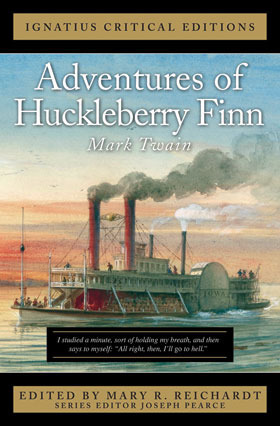 in a democracy, what is the nature of freedom, citizenship, human dignity, political participation, equality between races, etc.?). Such questions are certainly epic in scope. While one can cite many examples of slavery's impact upon American culture in Huck Finn, two will serve to demonstrate the vast cultural and social tensions in the early nineteenth century: the attitudes of Pap and Silas Phelps regarding race and slavery. Pap's splenetic tirade in chapter 6, uttered in a drunken rage in the cabin where Pap has imprisoned Huck, captures America's divided mind in the decades preceding the Civil War. The object of Pap's contempt seems all of society itself, including the government, the free market, educational institutions, and even the right to vote, all on account of the emerging reality of black men and women becoming freed from slavery and entering civil society. He is outraged because a black man of mixed blood is more educated, wealthier, and more capable of exercising his voting rights than Pap himself. ...
in a democracy, what is the nature of freedom, citizenship, human dignity, political participation, equality between races, etc.?). Such questions are certainly epic in scope. While one can cite many examples of slavery's impact upon American culture in Huck Finn, two will serve to demonstrate the vast cultural and social tensions in the early nineteenth century: the attitudes of Pap and Silas Phelps regarding race and slavery. Pap's splenetic tirade in chapter 6, uttered in a drunken rage in the cabin where Pap has imprisoned Huck, captures America's divided mind in the decades preceding the Civil War. The object of Pap's contempt seems all of society itself, including the government, the free market, educational institutions, and even the right to vote, all on account of the emerging reality of black men and women becoming freed from slavery and entering civil society. He is outraged because a black man of mixed blood is more educated, wealthier, and more capable of exercising his voting rights than Pap himself. ...
The main character of Adventures of Huckleberry Finn are complex individuals traversing an epic terrain that is both ethical and theological in significance. Even though Huck and Jim are caught within their era's cultural quandaries, they themselves are not political, social, or religious crusaders but individuals struggling to resolve their own problems. As brilliantly crafted by Twain, neither Jim's nor Huck's character is a thin symbolic representation of an abstract social, political, or moral ideal. They are not abolitionists out to change the hearts and minds of America regarding the issue of slavery. Rather, like all great epic heroes, Huck is a psychologically realistic character, and as such embarks upon an epic journey that runs along two concurrent registers: ethical and theological. His moral sensibilities and his theological bearings become radically altered as he struggles with his decision to abet a fugitive slave who willfully abandoned his master. In fact, the effect of the journey upon his own soul threaten to destabilize the moral and theological structure of the universe as he (and his nation) know it.
If Huck Finn can be called an American Odyssey, the journey begins at the ethical level for Huck. At a superficial level, Huck exhibits the typical American pragmatism toward morality: moral ideals are nice but not always practical in the face of real-world problems. For instance, Huck, in a moment of complex moral casuistry, explains the difference between "borrowing" and "stealing" something: "Pap always said it warn't no harm to borrow things, if you was meaning to pay them back, sometime; but the widow said it warn't anything but a soft name for stealing, and no decent body would do it. Jim said he reckoned the widow was partly right and pap was partly right" (see p. 77). Huck even expresses his frustration with matters of moral principle: "[I]t don't make no difference whether you do right or wrong, a person's conscience ain't got no sense, and just goes for him anyway. If I had a yaller dog that didn't know no more than a person's conscience does, I would pison him. It takes up more room than all the rest of a person's insides, and yet ain't no good, nohow" (see p. 258).
Yet Huck is hardly a boy without a conscience; his frustration comes from the fact that while he may not always act in the most ethical fashion, he has a very sensitive and developed conscience. Huck is a deeply empathetic boy who keenly feels the pain of those around him. He also has a sharp intuition for justice and injustice, so much that he cannot repress his mental and emotional reactions when he observes them in his immediate surroundings. ...
Huck's struggle does not simply involve the moral probity of one isolated act or set of acts (such as helping one black slave "illicitly" gain his freedom); his struggle represents a clash of two violently opposed world views and moral systems. The voice of Huck's conscience represents a particular social value code, certain dimensions of which are deeply racist and inhumane. This value code, which Huck has internalized, accepts chattel slavery as a perfectly permissible and profitable social institution. This code also dogmatically maintains the subhuman status of black men, women, and children as a natural God-given fact. In this view, they are moral creature only when considered as property, and when viewing Jim's situation from the perspective of property rights, Huck can see only that he is maliciously defrauding a generous old widow of what belongs to her.
Yet Huck becomes aware of a competing value code that asserts the opposite of the one in which he has been raised, and the clash of these two codes within his soul is truly epic. As Huck travels with Jim, he begins to see Jim as a person in his own right, possessing the dignity Huck was used to acknowledging only in other whites. For instance, in chapter 15, Huck humbles himself to Jim after cruelly trying to trick him into thinking their separation in the fog was only a dream; in chapter 16, Huck discovers the intense loyalty and devotion Jim has to his wife and children when he hears Jim relate how, once free, he will work to purchase their freedom; and in chapter 23, Huck empathizes with Jim's identity as a loving father who had wrongfully beaten his daughter for what Jim had perceived as disrespectful behavior. Jim emerges in Huck's mind as that which the voice of his conscience cannot accept: a dignified human being and a man worthy of empathy, respect, and admiration. The violent tension between these two value codes becomes clear in Huck's problematic affirmation of Jim's nobility and dignity in chapter 40, when Jim insists on getting a doctor to save Tom Sawyer's life because Tom would have done the same thing for him. Huck effusively proclaims, "I knowed [Jim] was white inside" (see p. 304), as a matter of genuine admiration; yet this affirmation is tragically racialized. Huck can still conceive of a "true" human being only as "white", even if only on the "inside". While Huck is shedding a world view containing racist and unjust elements for something more just and virtuous, his transformation is incomplete.
Yet the most cosmic and cataclysmic dimension of Huck's epic struggle pertains to the theological foundations of creation, specifically God's Providence regarding Heaven and Hell. The novel evokes Heaven and Hell purposefully, as their significance becomes inverted for Huck as a result of his transformation in value systems. The movement in Huck's soul from viewing Jim as mere property to appreciating him as a fellow human being is not only a seismic shift in Huck's ethical world view; it is also a traumatic revaluation of the significance of Heaven and Hell. Early in the novel, Huck is instructed on the significance of Heaven and Hell as eternal reward and punishment by the Widow Douglas and Miss Watson. This education takes place in the context of the two ladies' attempt to "sivilize" Huck and is roundly comic. For example, according to Huck, Miss Watson describes Heaven as a place where one just "go[es] around all day long with a harp and sing[s], forever and ever", to which Huck responds, "I didn't think much of it" (see p. 7). The comedy is equally hilarious in Huck's reaction to her depiction of Hell: "Then she told me all about the bad place, and I said I wished I was there. She got mad, then, but I didn't mean no harm. All I wanted was to go somewheres; all I wanted was a change, I warn't particular" (see p. 7). In this early episode, Heaven and Hell are mere abstractions for Huck (and fodder for Twain's irreverent wit); they have little practical relevance for his life. Yet the eternal dimensions of the cosmos become frighteningly real and terrifyingly inverted for Huck. Heaven and Hell will cease to be comic abstractions and will take on a deadly significance for his understanding of himself and his future.
More about this volume from IgnatiusCriticalEditions.com:
Mark Twain's Adventures of Huckleberry Finn is, according to many critics and fond readers, the great American novel. Full of vibrant American characters, intriguing regional dialects and folkways, and down-home good humor, it also hits Americans in one of their greatest and on-going sore spots: the fraught issue of racism.
As Huck and Jim float down the Mississippi and encounter all manner of people and situations, and as Huck struggles mightily with his conscience concerning Jim, the novel strongly invites a moral and religious perspective. Mary R. Reichardt, the editor of this edition, is a professor of literature in the Catholic Studies department at the University of St. Thomas in St. Paul MN.
A look at the essays
"Camp meetings", or revivals, show up in Huck's adventures and in Twain's library. Fr. Anthony J. Berret, SJ, shows how this religious practice lends form to the narrative.
William F. Byrne shows how Huck Finn is not just un-Romantic, but anti-Romantic in "Huckleberry Finn as a Response to Romanticism", while John F. Devanney, Jr. navigates the troubled waters of morality in the tale: why Twain was afraid people would impose a moral on his work, and how critics have done so despite him.
In "Huck's Sound Heart", Thomas W. Stanford III investigates the conflicts of conscience that pervade the work. Aaron Urbanczyk offers "Huckleberry Finn as American Epic", the story of a young and unsettled boy in a young and unsettled country.
Mary Reichardt situates the reader with the introductory essay.
Holy Week Reflection on Pope Benedict XVI's "Jesus of Nazareth" at DSPT
The Dominican School of Philosophy and Theology (Berkeley, CA) will be hosting a Holy Week Reflection on Pope Benedict XVI's Jesus of Nazareth: Holy Week on Wednesday, April 20th, at 7:30 p.m.:
In the second volume of his study of Jesus, Pope Benedict takes up what happened in the final week of Christ's earthly life: was he a political revolutionary? How did Jesus understand his own sufferings and death? How should we understand his resurrection, and what relevance does it have for us today? Our panel will engage these and other questions in an evening of reflection and discussion, as we prepare to celebrate Easter.
For further information, visit the school's website.
March 19, 2011
Lent and the Transfiguration
A Scriptural Reflection on the Readings for the Second Sunday of Lent, March 20, 2011 | Carl E. Olson
Readings:
• Gen. 12:1-4a
• Psa. 33:4-5, 18-19, 20, 22
• 2 Tim. 1:8b-10
• Matt. 17:1-9
What words come to mind when you think of Lent? Some that pop into my head include repentance, reflection, testing, growth, fasting, giving, and prayer. Why, then, does today's Gospel focus on the 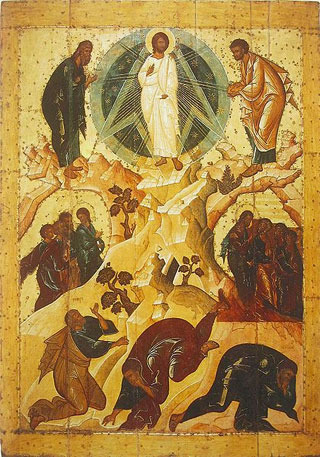 Transfiguration? During this season of spiritual examination, why do we hear of a mysterious, dramatic, and glory-filled episode on a mountain?
Transfiguration? During this season of spiritual examination, why do we hear of a mysterious, dramatic, and glory-filled episode on a mountain?
Saint Thomas Aquinas, in answering the question, "Was it fitting that Christ should be transfigured?" (Summa Theologica, 3, 45, I), wrote, "I answer that, Our Lord, after foretelling His Passion to His disciples, had exhorted them to follow the path of His sufferings (Matthew 16:21-24). Now in order that anyone go straight along a road, he must have some knowledge of the end: thus an archer will not shoot the arrow straight unless he first see the target." Although the glory of the Transfiguration might seem to be far removed from the challenges of Lent, it actually provides us the hope and direction we need in order for this season to truly be about becoming more closely conformed to the likeness of Christ. If Lent is a journey through the desert, the Transfiguration provides the light to walk the path and the end toward which we direct our steps.
Another related connection can be found in how the Transfiguration revealed, in stunning splendor, the divinity and holiness of Christ. This revelation came, as it were, while the disciples were struggling with blindness about the mission undertaken by Jesus. Matthew's Gospel describes how, not long before the Transfiguration, Jesus had rebuked Peter when the head apostle vehemently rejected the notion that his Lord would have to soon die (Matt 16:21-28). True life, Peter and the disciples were told by their Master, consists of taking up the cross and dying to oneself. "Truly, I say to you," Jesus told them, "there are some standing here who will not taste death before they see the Son of man coming in his kingdom."
The Transfiguration was a vividly experienced foretaste of the Kingdom. It demonstrated to the disciples that the words of Christ were true, and that the beloved Son knew exactly what He was doing, as His heavenly Father confirmed: "Listen to him." During Lent—or during any trying time in our lives—we may begin to doubt the words and ways of God and wonder if He really knows what He is doing. The Transfiguration is a reminder that the glory and presence of God is indeed with us, even when we struggle through days wet with tears and nights filled with sorrows.
What the disciples witnessed on the mountain was also an illuminating glimpse into God's plan of salvation. Although Moses had seen God and spoken to Him on Mount Sinai, he couldn't look God in the face or gaze upon the fullness of God's glory (Exodus 33:18-23). Elijah, while on the mountain, hid from the presence of God (1 Kings 19:1-14). Man can only be saved by God, but is unworthy to look upon His face. By becoming man, God approaches man and draws him into the divine life. "But only on the mountain of the Transfiguration," the Catechism notes, "will Moses and Elijah behold the unveiled face of him whom they sought" (CCC 2583).
Moses and Elijah represent the Law and the Prophets, each of which gives witness to Christ, who is the new lawgiver and new prophet of the new and everlasting covenant. He is also, as Paul wrote to Timothy, "our savior Christ Jesus who destroyed death and brought life and immortality to light through the gospel" (2 Tim 1:10). The Transfiguration of the Son of God points to the reality of our own transfiguration, by the work of Christ—especially through the Eucharist (CCC 1000)—into sons and daughters of God.
In the desert of Lent we seek, by God's grace, to meet the Savior face to face and to be transformed by His Transfiguration, all of the darkness of our souls destroyed by the light of His face.
(This "Opening the Word" column originally appeared in the February 17, 2008, edition of Our Sunday Visitor newspaper.)
• Through the Desert, Back to the Tree of Life | A Scriptural Reflection on the Readings for March 13, 2011 | First Sunday of Lent | Carl E. Olson
Given three gifts, Saint Joseph did three essential things
The following is an "Opening the Word" column I wrote for Our Sunday Visitor newspaper about the readings for the Fourth Sunday of Advent last year (Dec. 19, 2010). The Gospel reading for that Sunday is from the same section, Matthew 1:18ff., as is today's Gospel reading on the Solemnity of Saint Joseph, husband of the Blessed Virgin Mary:
"Looking on thee, O Unwedded One, and dreading a hidden wedlock, O Sinless One, the chaste Joseph was riven in mind with a storm of doubts…"
That is how the anxious state of Joseph was poetically described by the unknown author of the great Akathist hymn (c. 6th century) to the blessed Virgin Mary as he considered what to do with his young and pregnant betrothed. Joseph, following the usual Jewish practice, had been covenanted to Mary; their engagement was, for all intents and purposes, as legally binding as marriage. According to Jewish law, this meant the engagement could only end in one of two ways: divorce or death (Deut. 24:1-4).
Although devotion to St. Joseph has grown tremendously in recent centuries, it is still easy to overlook both the tremendous decisions he faced and the great character he demonstrated in making those decisions. Today's reading from the Gospel of Matthew describes Joseph as a "righteous man". This is not some vague reference to Joseph simply being a nice guy, but is a direct recognition of his whole-hearted commitment to the Law. "And it will be righteousness for us," said the Hebrews at Mount Sinai, upon being given the Decalogue, or Ten Commandments, "if we are careful to do all this commandment before the Lord our God, as he has commanded us" (Deut. 6:25). Joseph was careful to follow the commandments; he desired to love and serve God completely.
Yet he was faced with a gut-wrenching, scandalous situation: a young bride who was already pregnant. However, Joseph was "unwilling to expose Mary to shame" and had decided to divorce her—or, better translated, "to send her away quietly". Some of the Church fathers and doctors believed that Joseph had suspected Mary of adultery. Others thought he had withheld moral judgment, being genuinely perplexed by the strange situation. And some, including St. Thomas Aquinas, believed Joseph knew of the miraculous nature of Mary's pregnancy from the start, and had sought to separate himself from her because of a deep sense of unworthiness.
So we don't know what Joseph knew prior to the angel of the Lord appearing to him. Rather remarkably, we also don't know what Joseph may have said, simply because not one word that he uttered is recorded! But we do learn some important things from the words of the angel, as well as from Joseph's actions.
The angel provided Joseph with three essential gifts and truths. First, the divine messenger granted him the gift of peace: "Do not be afraid to take Mary your wife into your home." The coming of the Lord is always a gift of peace to those who love and serve him. Secondly, he told Joseph there was a divine plan in place: Mary will give birth to Jesus—which means "Yahweh saves"—who will save his people from sin. Joseph would surely have recognized this as a description of the long-awaited Messiah. Finally, the angel provided the prophetic background to this stunning event, the passage from Isaiah 7, today's reading from the Old Testament. This would have further reinforced the reality of the divine plan.
Joseph, in turn, did three things. He thought, first and foremost, about Mary and her well-being. He acted justly, without concern for himself, even though he had every legal right to be upset. A good husband puts the needs and reputation of his wife before his own. Secondly, he placed his trust and hope in God's promise. Although we never hear any words from Joseph, we are told of his actions. A godly man walks the talk, but with a minimum of talk! Third, Joseph embraced the daunting task of being the foster father of the Son of God. Why? Because he trusted in God despite the strangeness of the situation.
And what is the conclusion of the verse of the Akathist hymn quoted above? "…but learning that your conception was of the Holy Spirit, he cried out: 'Alleluia!'" Alleluia, indeed!
• The Importance of Knowing St. Joseph | Fr. Benedict Groeschel, C.F.R. | The Introduction to The Mystery of Joseph by Marie-Dominique Philippe, O.P. |
Carl E. Olson's Blog
- Carl E. Olson's profile
- 20 followers



